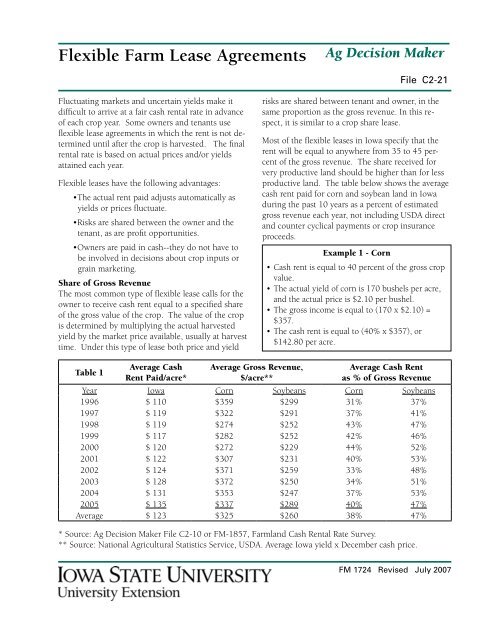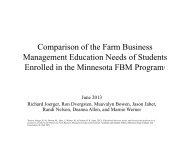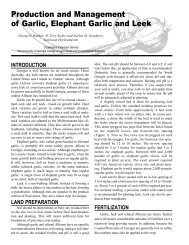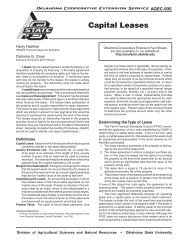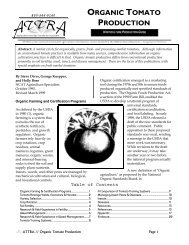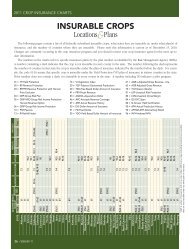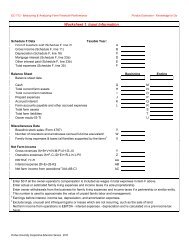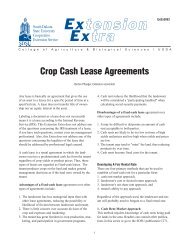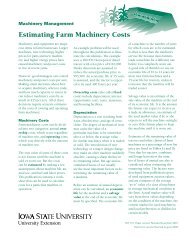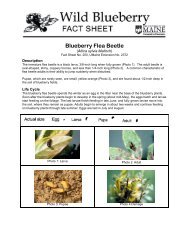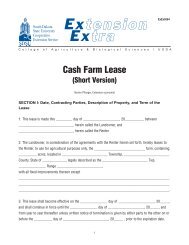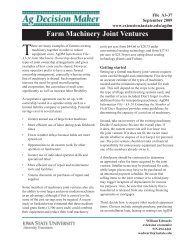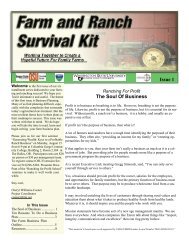Flexible Farm Lease Agreements - National Ag Risk Education Library
Flexible Farm Lease Agreements - National Ag Risk Education Library
Flexible Farm Lease Agreements - National Ag Risk Education Library
Create successful ePaper yourself
Turn your PDF publications into a flip-book with our unique Google optimized e-Paper software.
<strong>Flexible</strong> <strong>Farm</strong> <strong>Lease</strong> <strong><strong>Ag</strong>reements</strong><br />
<strong>Ag</strong> Decision Maker<br />
File C2-21<br />
Fluctuating markets and uncertain yields make it<br />
difficult to arrive at a fair cash rental rate in advance<br />
of each crop year. Some owners and tenants use<br />
flexible lease agreements in which the rent is not determined<br />
until after the crop is harvested. The final<br />
rental rate is based on actual prices and/or yields<br />
attained each year.<br />
<strong>Flexible</strong> leases have the following advantages:<br />
•The actual rent paid adjusts automatically as<br />
yields or prices fluctuate.<br />
•<strong>Risk</strong>s are shared between the owner and the<br />
tenant, as are profit opportunities.<br />
•Owners are paid in cash--they do not have to<br />
be involved in decisions about crop inputs or<br />
grain marketing.<br />
Share of Gross Revenue<br />
The most common type of flexible lease calls for the<br />
owner to receive cash rent equal to a specified share<br />
of the gross value of the crop. The value of the crop<br />
is determined by multiplying the actual harvested<br />
yield by the market price available, usually at harvest<br />
time. Under this type of lease both price and yield<br />
risks are shared between tenant and owner, in the<br />
same proportion as the gross revenue. In this respect,<br />
it is similar to a crop share lease.<br />
Most of the flexible leases in Iowa specify that the<br />
rent will be equal to anywhere from 35 to 45 percent<br />
of the gross revenue. The share received for<br />
very productive land should be higher than for less<br />
productive land. The table below shows the average<br />
cash rent paid for corn and soybean land in Iowa<br />
during the past 10 years as a percent of estimated<br />
gross revenue each year, not including USDA direct<br />
and counter cyclical payments or crop insurance<br />
proceeds.<br />
Example 1 - Corn<br />
• Cash rent is equal to 40 percent of the gross crop<br />
value.<br />
• The actual yield of corn is 170 bushels per acre,<br />
and the actual price is $2.10 per bushel.<br />
• The gross income is equal to (170 x $2.10) =<br />
$357.<br />
• The cash rent is equal to (40% x $357), or<br />
$142.80 per acre.<br />
Table 1<br />
Average Cash<br />
Rent Paid/acre*<br />
Average Gross Revenue,<br />
$/acre**<br />
Average Cash Rent<br />
as % of Gross Revenue<br />
Year Iowa Corn Soybeans Corn Soybeans<br />
1996 $ 110 $359 $299 31% 37%<br />
1997 $ 119 $322 $291 37% 41%<br />
1998 $ 119 $274 $252 43% 47%<br />
1999 $ 117 $282 $252 42% 46%<br />
2000 $ 120 $272 $229 44% 52%<br />
2001 $ 122 $307 $231 40% 53%<br />
2002 $ 124 $371 $259 33% 48%<br />
2003 $ 128 $372 $250 34% 51%<br />
2004 $ 131 $353 $247 37% 53%<br />
2005 $ 135 $337 $289 40% 47%<br />
Average $ 123 $325 $260 38% 47%<br />
* Source: <strong>Ag</strong> Decision Maker File C2-10 or FM-1857, <strong>Farm</strong>land Cash Rental Rate Survey.<br />
** Source: <strong>National</strong> <strong>Ag</strong>ricultural Statistics Service, USDA. Average Iowa yield x December cash price.<br />
FM 1724 Revised July 2007
Page <br />
Base Rent plus Bonus<br />
Another type of flexible lease specifies a base or<br />
minimum rent, plus the owner receives a share of<br />
the gross revenue in excess of a certain base value.<br />
The base value may be the gross revenue that would<br />
be received under typical yield and price conditions.<br />
The bonus may vary from one-third to one-half<br />
of the amount over the base revenue. Both parties<br />
must agree on how to calculate gross revenue,<br />
whether other payments are included in the calculation,<br />
and whether a gross revenue below the base<br />
level will cause the actual rent to be less than the<br />
base rent value. If the base rent is specified as the<br />
minimum rent, it should probably be set lower than<br />
a typical fixed cash rent for the same land; otherwise,<br />
the landowner would not share in any of the<br />
downside risk.<br />
Example 2 - Soybeans<br />
• Base rent is $100 per acre. Expected gross revenue<br />
is $225 per acre. Bonus is 50% of the gross<br />
revenue in excess of $250.<br />
• Actual yield is 52 bushels of soybeans per acre<br />
and actual price is $6.50 per bushel.<br />
• Gross Revenue is equal to (52 bu. x $6.50) =<br />
$338 per acre.<br />
• Revenue in excess of the base of $250 = $338<br />
- $250 = $88<br />
• Rent is equal to $100 plus 50% of $88, or $100 +<br />
$44 = $144.<br />
• However, if the market price of soybeans was<br />
only $5.00 per bushel, the gross revenue would<br />
be only $260, and the bonus would be ($260<br />
- $250) x 50% = $5, and the rent would be $105<br />
per acre.<br />
Sharing <strong>Risk</strong><br />
Owners and tenants should carefully consider the<br />
type and degree of risk they want to assume. Taking<br />
on risk means greater losses when prices or yields<br />
are low, but can result in larger profits in better<br />
years. Owners who wish to receive a fixed income<br />
from their farm investments may have to accept a<br />
lower rent than those who are willing to share risk.<br />
Tenants with substantial financial obligations should<br />
consider adopting other means of reducing risk, as<br />
well, such as purchasing crop revenue insurance.<br />
<strong>Lease</strong>s that base the rent on price only or yield only<br />
may actually increase the tenant’s risk in some years.<br />
This is because prices may be high when yields are<br />
low, or prices may be low when yields are high.<br />
Thus, adjusting the rent based on only one factor<br />
does not always reflect the actual profits received<br />
in that year. Adjusting the rent for changes in both<br />
price and yield ensures that the actual rent will be<br />
closely tied to the tenant’s income each year.<br />
Determining Yield<br />
It is important to agree ahead of time on the procedure<br />
for determining the factors that will be used<br />
to calculate the final rent. These factors should be<br />
based on information that is available to both parties.<br />
Actual yields can be determined by:<br />
•weight tickets, if all the crop is sold or put into<br />
commercial storage<br />
•combine yield monitors or weigh wagons<br />
•storage bin capacity<br />
When crops stored on the farm are ultimately sold,<br />
any variation from the estimated yield can be used to<br />
adjust the rent paid for that crop. Estimated yields<br />
should be corrected to a standard moisture level, for<br />
example, 15 percent moisture for corn.<br />
Determining Price<br />
The price used to calculate the final rent payment<br />
can be the cash price at a local elevator or processor<br />
on a specified date, or an average of prices on several<br />
dates. Prices on dates near or before the time the final<br />
rent is paid should be used even though the crop<br />
may actually be sold later, unless the landowner is<br />
providing storage facilities. Forward contract prices<br />
available before harvest can be included, too.
Page <br />
An alternative to using a local price is to use a futures<br />
contract price minus a normal basis value for<br />
the location of the farm. If the price chosen is lower<br />
than the USDA county loan rate for that commodity,<br />
the loan rate can be used instead. This would represent<br />
the tenant’s potential selling price including loan<br />
deficiency payments or gains from USDA marketing<br />
loans.<br />
Minimum and Maximum Rents<br />
Some tenants and landlords may want to avoid the<br />
possibility of a very high or very low rent in a given<br />
year by setting a maximum and/or minimum rent.<br />
This keeps the actual rent paid each year within a<br />
desirable range. Many leases ask for a portion of the<br />
rent to be paid in advance. Under a flexible lease,<br />
the advance payment may be for a fixed amount<br />
while the final payment depends on actual prices<br />
and yields.<br />
The flexible lease formula to be followed should<br />
be tested by using several different price and yield<br />
possibilities so as to illustrate the range of potential<br />
cash rents. Regardless of what type of agreement<br />
is adopted, it should be described in writing (with<br />
an example) and made a part of the written lease<br />
contract. The following page can be used as a lease<br />
supplement to specify flexible lease terms.<br />
Government Payments<br />
The <strong>Farm</strong> Service <strong>Ag</strong>ency (FSA) specifies that under<br />
a lease arrangement in which yield risk is shared<br />
between the tenant and the landowner, any direct<br />
payments and counter cyclical payments for which<br />
the farm may qualify must be shared in the same<br />
proportion as the risk. This is similar to the sharing<br />
of payments under a crop share lease. In such cases,<br />
these payments should not be included in the gross<br />
revenue estimates used to determine the amount of<br />
rent due, such as in examples 1 and 2 in this publication.<br />
Tenants and landlords who agree on a flexible cash<br />
lease should provide a copy of it to their county FSA<br />
office, and request approval for the proposed sharing<br />
of the direct and counter cyclical payments. <strong>Flexible</strong><br />
leases in which the rent is based on the actual<br />
market price and a fixed yield, or a yield such as the<br />
county average yield each year, do not require a division<br />
of USDA payments.<br />
Other Resources<br />
ISU Extension publication FM 1538 or <strong>Ag</strong> Decision<br />
Maker File C2-12 contains a standard farm lease<br />
form. ISU Extension publication FM 1801 or <strong>Ag</strong><br />
Decision Maker File C2-20 contains information on<br />
how to determine a fair cash rent.<br />
An interactive spreadsheet to analyze flexible farm<br />
lease agreements is available on the <strong>Ag</strong> Decision<br />
Maker web site at: www.extension.iastate.edu/agdm/<br />
wholefarm/xls/c2-21flexiblerentanalysis.xls .<br />
. . . and justice for all<br />
The U.S. Department of <strong>Ag</strong>riculture (USDA) prohibits discrimination in<br />
all its programs and activities on the basis of race, color, national origin,<br />
gender, religion, age, disability, political beliefs, sexual orientation, and<br />
marital or family status. (Not all prohibited bases apply to all programs.)<br />
Many materials can be made available in alternative formats for ADA<br />
clients. To file a complaint of discrimination, write USDA, Office of<br />
Civil Rights, Room 326-W, Whitten Building, 14th and Independence<br />
Avenue, SW, Washington, DC 20250-9410 or call 202-720-5964.<br />
Issued in furtherance of Cooperative Extension work, Acts of May 8 and<br />
June 30, 1914, in cooperation with the U.S. Department of <strong>Ag</strong>riculture.<br />
Jack M. Payne, director, Cooperative Extension Service, Iowa State University<br />
of Science and Technology, Ames, Iowa.<br />
File: Economics 1 - 1<br />
William Edwards, extension economist<br />
(515) 294-6161, wedwards@iastate.edu<br />
Ann Holste, extension program specialist<br />
(515) 294-4197, aholste@iastate.edu<br />
www.extension.iastate.edu/agdm<br />
www.extension.iastate.edu/store
Page <br />
<strong>Flexible</strong> Cash Rent <strong>Ag</strong>reement<br />
The amount of cash rent to be paid by the operator to the owner for the portion of the real estate designated<br />
as cropland shall be determined as follows (fill in the blanks where needed):<br />
Corn Soybeans<br />
Area of cropland _________ _________ acres<br />
Base rent per acre (if applicable) $ _________ $ _________ per acre<br />
Base gross revenue (if applicable) $ _________ $ _________ per acre<br />
Percent of revenue to share (in excess of base) _________% _________%<br />
Minimum rent per acre (if applicable) $ _________ $ _________ per acre<br />
Maximum rent per acre (if applicable) $ _________ $ _________ per acre<br />
The actual yield use to calculate the rent shall be determined as follows: ______________________________<br />
________________________________________________________________________________________<br />
________________________________________________________________________________________<br />
________________________________________________________________________________________<br />
The actual price used to calculate the rent shall be determined as follows: _____________________________<br />
________________________________________________________________________________________<br />
________________________________________________________________________________________<br />
________________________________________________________________________________________<br />
The value of any payments received as the result of participation in programs of the United States Department<br />
of <strong>Ag</strong>riculture for the crop year for which the variable cash rent applies shall be divided as follows:_________<br />
________________________________________________________________________________________<br />
________________________________________________________________________________________<br />
________________________________________________________________________________________<br />
________________________________________________________________________________________
Page <br />
<strong>Flexible</strong> Rent to Pay<br />
The tables below can be used to record the rent that would be due under various combinations of<br />
prices and yields, based on the approaches described in this publication.<br />
<strong>Flexible</strong> Rent to Pay - Corn ($ per acre)<br />
Actual Price, $ per bushel<br />
Actual Yield,<br />
Bu. per Acre<br />
Under<br />
$1.50<br />
$1.50 to<br />
$1.99<br />
$2.00 to<br />
$2.49<br />
$2.50 to<br />
$2.99<br />
$3.00 to<br />
$3.49<br />
$3.50 to<br />
$3.99<br />
$4.00 or<br />
more<br />
Under 50<br />
50-74<br />
75-99<br />
100-124<br />
125-149<br />
150-174<br />
175-199<br />
200-224<br />
225-249<br />
250+<br />
<strong>Flexible</strong> Rent to Pay - Soybeans ($ per acre)<br />
Actual Price, $ per bushel<br />
Actual Yield,<br />
Bu. per Acre<br />
Under<br />
$4.00<br />
$4.00 to<br />
$4.99<br />
$5.00 to<br />
$5.99<br />
$6.00 to<br />
$6.99<br />
$7.00 to<br />
$7.99<br />
$8.00 to<br />
$8.99<br />
$9.00 or<br />
more<br />
Under 25<br />
25-29<br />
30-34<br />
35-39<br />
40-44<br />
45-49<br />
50-54<br />
55-59<br />
60-64<br />
65+


